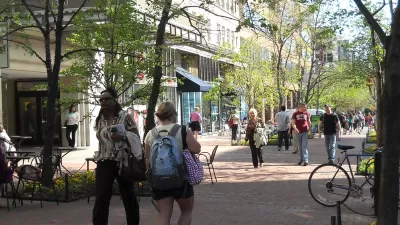Millennials and an aging Baby Boomer population have put a premium on "the hottest trend in real estate": walkability.

Via the Huffington Post, F. Kaid Benfield of PlaceMakers writes that the most sought after amenity for renters and buyers is now 'walkability'. Access to services, shops, restaurants and transportation is now a huge consideration for millennials and baby boomers, whether they prefer to live in the suburbs or in the urban core. Benfield cites a nationwide survey by the National Association of Realtors and Portland State University that found 'walkability' as an important factor in the selection of where people live.
Across all generations, the Realtors/Portland State survey found that an overwhelming majority of respondents - 79 percent - believe it to be very or somewhat important, in choosing a home, to be "within an easy walk of other places and things in the community." It also found that people who now live in such neighborhoods are especially satisfied with the quality of life in their communities. Fifty-four percent of those respondents who agreed with the statement "there are lots of places to walk nearby, such as shops, cafes, and restaurants" reported being very satisfied with the quality of life in their communities; only 41 percent of all respondents reported being very satisfied.
Benfield notes that while most cities across the United States have areas that can be considered 'walkable', there aren’t enough to meet demand.
And, because their supply is limited, prices for walkable locations are sky-high. Research has shown that each one-point increase in a home's Walk Score (a 100-point scale measuring an address's accessibility to walkable destinations) is associated with a $700 to $3000 increase in its value compared to less walkable homes of comparable size.
So what can be done to create more walkable areas in our cities and suburbs? Banfield offers a few good solutions, including the implementation of form-based codes and a focus on LEED for Neighborhood Development when updating that existing zoning codes.
FULL STORY: We Want More Walkable Neighborhoods -- but Can Our Communities Deliver?

Florida Considers Legalizing ADUs
Current state law allows — but doesn’t require — cities to permit accessory dwelling units in single-family residential neighborhoods.

Manufactured Crisis: Losing the Nation’s Largest Source of Unsubsidized Affordable Housing
Manufactured housing communities have long been an affordable housing option for millions of people living in the U.S., but that affordability is disappearing rapidly. How did we get here?

Americans May Be Stuck — But Why?
Americans are moving a lot less than they once did, and that is a problem. While Yoni Applebaum, in his highly-publicized article Stuck, gets the reasons badly wrong, it's still important to ask: why are we moving so much less than before?

EV Chargers Now Outnumber Gas Pumps by Nearly 50% in California
Fast chargers still lag behind amidst rapid growth.

Affordable Housing Renovations Halt Mid-Air Amidst DOGE Clawbacks
HUD may rescind over a billion dollars earmarked for green building upgrades.

Has Anyone at USDOT Read Donald Shoup?
USDOT employees, who are required to go back to the office, will receive free parking at the agency’s D.C. offices — flying in the face of a growing research body that calls for pricing parking at its real value.
Urban Design for Planners 1: Software Tools
This six-course series explores essential urban design concepts using open source software and equips planners with the tools they need to participate fully in the urban design process.
Planning for Universal Design
Learn the tools for implementing Universal Design in planning regulations.
City of Moreno Valley
Institute for Housing and Urban Development Studies (IHS)
City of Grandview
Harvard GSD Executive Education
NYU Wagner Graduate School of Public Service
City of Cambridge, Maryland
Newport County Development Council: Connect Greater Newport



























